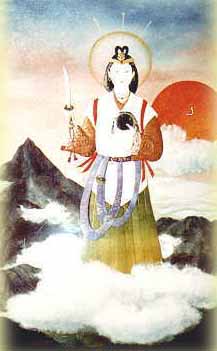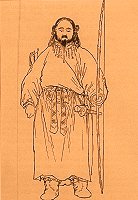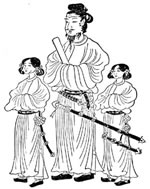 |
|||||
 |
|||||
 |
|||||
 |
|||||
 |
|||||
 |
|||||
 |
|||||
 |
|||||
 |
|||||
 |
|||||
 |
|||||
 |
|||||
 |
|||||
 |
|||||
Early Japan30,000 BC to 710 AD |
|
||||||||||||||||||||||||||||||||||||||||||||||||||||||||||||||||||||||||||||||||||||||||||||||||||
HINTO | MYTH OF AMATERASU | EARLY SETTLMENT | EMPEROR JIMMU | YAMOTO CLAN | GENERAL BUDDHISM | MAHAYANA | PRINCE SHOTOKU AND REFORM
Shintoism is the native religion of Japan with roots back to 600 BC. It is a polytheistic religion based on animism. It reveres natural objects like mountains, rivers, water, rocks and trees as having spirits. Great warriors and leaders are also believed to be deities. The most appealing natural wonder is the Sun. The Sun Goddess is the principal god of Shinto. The Sun Goddess Amaterasu is believed to be the ancestor of the Imperial family. Click here to see a guide on Shinto Shrines.
 Shinto
has its own creation
myths. According to one myth, the goddess of sun, Amaterasu came to earth
after an argument with her brother and hid in a cave. With the sun hidden, the
world was plunged into darkness and evil. Other gods and goddesses held a party
to tempt Amaterasu out of the cave. Legend has she came out of the cave and
was grabbed by a powerful god. She was told to never hide again. The Japanese
refer to their country as Nippon. Japan is considered the Land of the Rising
Sun and their modern day flag perpetuates this connection.
Shinto
has its own creation
myths. According to one myth, the goddess of sun, Amaterasu came to earth
after an argument with her brother and hid in a cave. With the sun hidden, the
world was plunged into darkness and evil. Other gods and goddesses held a party
to tempt Amaterasu out of the cave. Legend has she came out of the cave and
was grabbed by a powerful god. She was told to never hide again. The Japanese
refer to their country as Nippon. Japan is considered the Land of the Rising
Sun and their modern day flag perpetuates this connection.
Early settlement of Japan can be traced back to 30,000 BC when people crossed from the Asian mainland over a land bridge. From 10,000 BC to 300 BC. a small group of hunter-gatherers called the Jomon lived in primarily central Honshu. This group was well known for their hand made pottery. What followed was the gradual development in areas like metalworking, and rice cultivation. This occurred in a period of time referred to as the Yayoi Period. It is named for the people who crossed into Japan from Northern China through the peninsula of Korea.
 The
Japanese calendar officially begins with the 660 BC , the year Jimmu Tenno,
the first emperor of Japan is believed to have taken the throne.with the first
emperor of Japan. Jimmu (or Jimmu) is said to be the great-great grandson of
Amaterasu. He was the youngest of four sons of Amatersu's great-grandson and
his wife Princess Tamayori, a younger sister of his mother. The foundation day
of Japan is said to be February 11, 660 BC. In 1872, the Meiji government proclaimed
February 11 Kenkoku Kinen-bi ("National Foundation Day"). The legend
states that Jimmu
Tenno moved east along the Inland Sea and subdued tribes as he went eventually
setting up the country in Yamato. What followed was 35 emperor's claiming to
have ancestry leading back to Jimmu Tenno.
The
Japanese calendar officially begins with the 660 BC , the year Jimmu Tenno,
the first emperor of Japan is believed to have taken the throne.with the first
emperor of Japan. Jimmu (or Jimmu) is said to be the great-great grandson of
Amaterasu. He was the youngest of four sons of Amatersu's great-grandson and
his wife Princess Tamayori, a younger sister of his mother. The foundation day
of Japan is said to be February 11, 660 BC. In 1872, the Meiji government proclaimed
February 11 Kenkoku Kinen-bi ("National Foundation Day"). The legend
states that Jimmu
Tenno moved east along the Inland Sea and subdued tribes as he went eventually
setting up the country in Yamato. What followed was 35 emperor's claiming to
have ancestry leading back to Jimmu Tenno.
Around 300 AD the Yamato family was able to unify Japan and set up a court in present day Osaka then called Naniwa. The Yamato section of Japan is a southwestern peninsula on Honshu. This area is very well known for being the receptacle of new ideas from mainland Asia. The court as well a many of the traditions are based on Korean ideas. Osaka is located on the Yamato Plain, the most fertile area of land in Japan. The rulers of this area had tombs in the shape of mounds called kofun. This too was Korean in origin. The larger the mound, the more important the ruler. The most significant of these was Nintoku, the tomb for Emperor Nintoku. It is longer than five football fields and holds twice the volume of the Great Pyramid of Cheops. During this time period, the Yamato rulers received craftspeople from the Paekche court in Korea. Beyond artistic ideas the Japanese imported Chinese writing, Confucian scholars.
In the 6th century, Buddhism was introduced to Japan from China by way of Korea. In comparison to the rest of Asia, Buddhism reached Japan last around 520 - 550 AD. One of the first schools of Buddhism to reach Japan was the Sanron school. This school came to Japan by way of a Korean monk named Ekwan in 625. It was spread even fourth by his students. One of its most famous followers was Prince Shotoku. While this school did not independently organize itself, all the Buddhist schools studied its teachings. It was extremely helpful in understanding Mahayana, one of the three main schools of Buddhism.
While all three are still active in Japan today, the Mahayana school is most often seen. Unlike the Teravada school that stresses monastic life, the Mahayana school promises salvation to all whether or not they are a monk. The Mahanyan sect of Buddhism believes in two types of enlightened beings the Nyorai and Bosatu. Each achieved spiritual enlightenment and serve as guardians, teachers, and saviors to the faithful. The Nyorai is synonymous for Buddha. There are a group of individuals who have historically been thought of as the Nyorai Group. Likewise, the Bosatu Group are those who achieve enlightenment but delay Buddhahood but instead remain on earth to help others achieve salvation. Whitin Mahanyan school there are a variety of sects. One sect was the Hosso school. In 653, a Japanese monk named Dosho went to China and studied Buddhism under the founder of the Fa-hsiang school. He returned to Japan and began teaching the Hosso school of Buddhism at the Guyan-go-ji monastery. It is through this school that Buddhist ideas from the Southern Monastery spread. One of his students,Gembo also went to China to study and returned in 735 to teach ideas from the Northern Monastery. This was more orthodox and neither teachings flourished like they did in China and India. Click here to see a guide on Buddhist Temples.
 Most
of the major Chinese adaptations in Japanese culture began under Prince Shotoku
(in Japanese, Shotoku Taishi, 573-621) during the reign of Empress Suiko. The
most important contribution was the writing and adoption of a Chinese-style
constitution in 604 A.D. This constitution had seventeen articles and was
based heavily on Confucianism. Due to the fact that Prince Shotoku was a Buddhist,
the Three Treasures of Buddhism is mentioned
in the second article. What followed this was a coup against Shotoku's clan,
the Soga. A new emperor, Kotoku Tenno (645-655) started a reform movement. The
Taika Reform Edicts were written in 645 A.D. by Confucian scholars in the
Yamato court. The edicts began the Japanese imperial system. It clarified that
the ruler was emperor ruling by the Decree of Heaven and not a clan leader.
It gave the emperor absolute power and control over all the former separate
states which were from that time on referred to as provinces. The Taika Reform
also wanted land redistribution. Land ownership, according the reforms, was
not hereditary, instead it went back to state ownership after the owner died.
Taxes were placed on silk, cotton, and labor. Conscription for military service
as well as building public works was introduced. What followed the reforms was
a power struggle over who should be emperor. In 662, Emperor Tenji took the
title tenno (heavenly sovereign). It helped to reinforce the divine origins
of the imperial family and keep them safe from political problems. The struggle
within the family about who should be emperor continued. Several codes amounting
in the ritsuryo system or national administration system were introduced over
time. The process began in 668 AD with subsequent codes being added in 689 and
701. During these reforms, Confucian and Chinese ideas became bigger parts of
the Japanese government including a central administration, light versus harsh
legal punishments, civil service exam systems. Also during this time period,
many women ruled as empress until succession was addressed during the Nara period.
The series of codes and reforms led to the need to have a permanent capital.
Nara was the place chosen to be the permanent capital in 710. This began the
definition of a new period in Japanese history.
Most
of the major Chinese adaptations in Japanese culture began under Prince Shotoku
(in Japanese, Shotoku Taishi, 573-621) during the reign of Empress Suiko. The
most important contribution was the writing and adoption of a Chinese-style
constitution in 604 A.D. This constitution had seventeen articles and was
based heavily on Confucianism. Due to the fact that Prince Shotoku was a Buddhist,
the Three Treasures of Buddhism is mentioned
in the second article. What followed this was a coup against Shotoku's clan,
the Soga. A new emperor, Kotoku Tenno (645-655) started a reform movement. The
Taika Reform Edicts were written in 645 A.D. by Confucian scholars in the
Yamato court. The edicts began the Japanese imperial system. It clarified that
the ruler was emperor ruling by the Decree of Heaven and not a clan leader.
It gave the emperor absolute power and control over all the former separate
states which were from that time on referred to as provinces. The Taika Reform
also wanted land redistribution. Land ownership, according the reforms, was
not hereditary, instead it went back to state ownership after the owner died.
Taxes were placed on silk, cotton, and labor. Conscription for military service
as well as building public works was introduced. What followed the reforms was
a power struggle over who should be emperor. In 662, Emperor Tenji took the
title tenno (heavenly sovereign). It helped to reinforce the divine origins
of the imperial family and keep them safe from political problems. The struggle
within the family about who should be emperor continued. Several codes amounting
in the ritsuryo system or national administration system were introduced over
time. The process began in 668 AD with subsequent codes being added in 689 and
701. During these reforms, Confucian and Chinese ideas became bigger parts of
the Japanese government including a central administration, light versus harsh
legal punishments, civil service exam systems. Also during this time period,
many women ruled as empress until succession was addressed during the Nara period.
The series of codes and reforms led to the need to have a permanent capital.
Nara was the place chosen to be the permanent capital in 710. This began the
definition of a new period in Japanese history.
to return to Mrs. O'Donnell's Home Page.
"Maintained according to the Lakeland
Central School District Web Page Policies and Guidelines."
“Clicking on the above links will direct you to site(s) outside the Lakeland
Central School District and the Lakeland High School server. The Lakeland Central
School District is not responsible for contents on external sites and servers,
nor does the district endorse the sponsors or advertising on these sites.”
This site was designed and maintained by Maureen
O'Donnell, a teacher at Lakeland
High School.
July 2005 Created - |
Thursday, July 28, 2005
Last Revised -